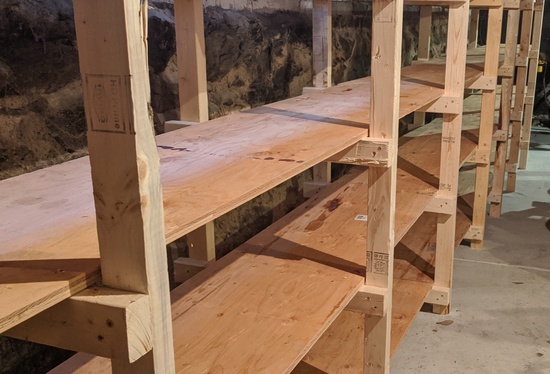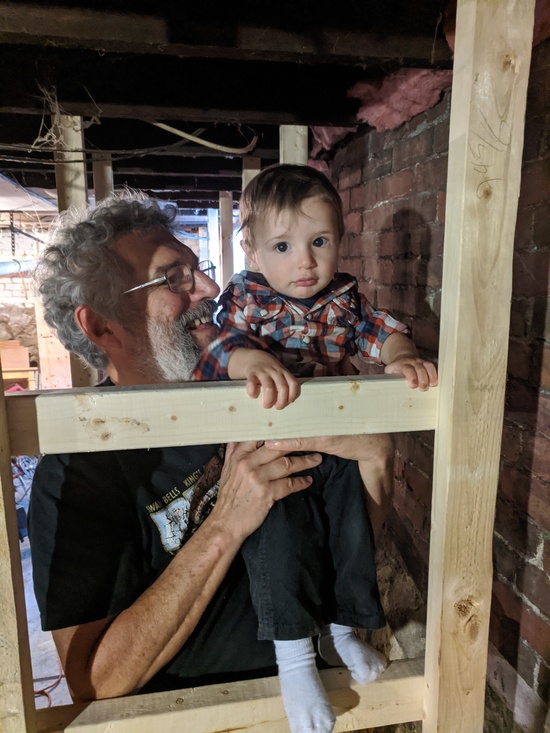Building Basement Shelving |
October 27th, 2019 |
| house |
The space available was about 22' long, though with some obstructions at each end: we didn't want to get too near the valve for draining the hose on one end, or block a window from opening on the other, so we ended up building something 21' long.
The basic plan was a series of "ladders" of 2x3s, attached to the floor joists above, with 16" plywood strips for the shelves sitting on the "rungs":
We sketched out the design ahead of time to plan materials: each "ladder" would need two 8' 2x3 for the rails, and five 24" 2x3s for the "rungs". With seven ladders, this came to twenty-three 2x3s. A 4x8 sheet of plywood gets you three 16" by 8' strips, so we needed five sheets. Then we needed four 3" (2 3/4" would have been better) construction screws per rung plus four more per ladder to attach to the joists, for a total of 168. And then two short screws (we used 1 1/4 but 1 1/2 would have been better) per rung to hold down the strips, or 70. So:
- 23 8' 2x3s plus some extras ($55)
- 5 4x8 sheets of 3/4 plywood ($125)
- 168 long screws ($15)
- 70 short screws ($5)
- total: ~$280 with delivery, or about $2.50 per foot of shelving
We ordered these to be delivered to the house: I'm generally very much in favor of having building materials delivered. We also had them cut the sheets into 16" strips, since these are cuts that are much easier to make on the store's panel saw.
We started by running a taut string along the underside of the rafters to mark where one side of the verticals would go. This made sure all the verticals would be aligned. While these are just basement shelves everything is still easier if we line things up well. We screwed the verticals to every other rafter along the string, about 32" apart, checking with a level to make sure they were plumb.
For the second set of verticals, parallel to the first, we decided to leave an 18" gap so there would be plenty of room for our 16" shelf boards. We cut a 18" spacer from a piece of scrap, and put up the second set of verticals, parallel to the first, with the spacer to make sure we left exactly an 18" gap.
We marked off one 18" shelf and four 15" shelves down from the rafters on one vertical in each pair: 18", 33", 48", 63", 78". This made sense, because the floor above was reasonably level. We transferred these marks to the other vertical with a level. We cut 35 24" lengths of 2x3 to use for rungs, and attached them to the verticals at the marks. We had some help:
We cut the middle section of shelf strips to length (61"), and left the two side sections at 8'. Then we put them in, and screwed them down.
It took us about 10:30 to 3:30, including lunch from ~2-2:30. They're solidly built and should last pretty much as long as the house does.
Comment via: facebook, substack

